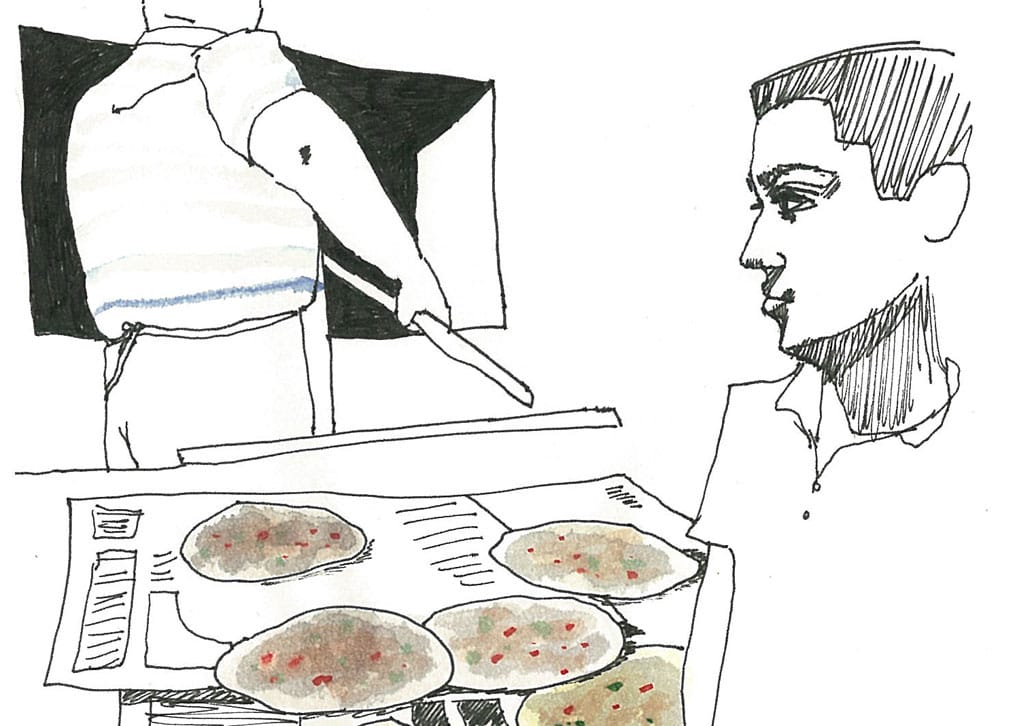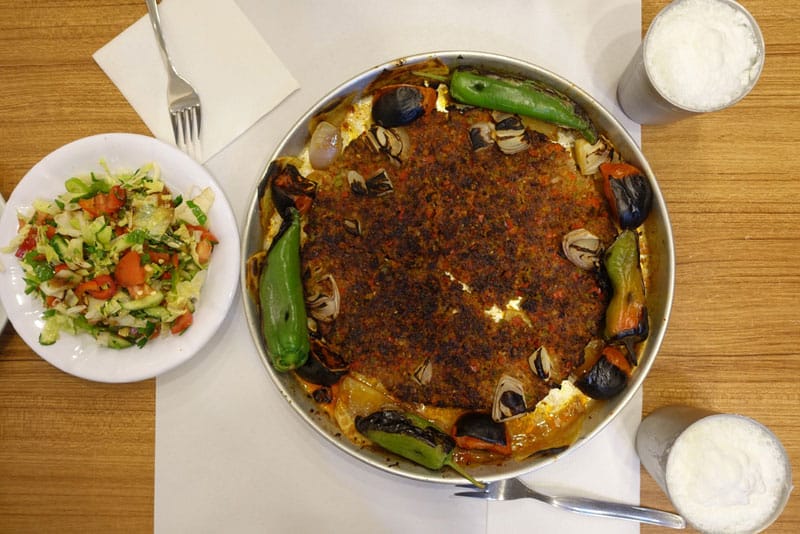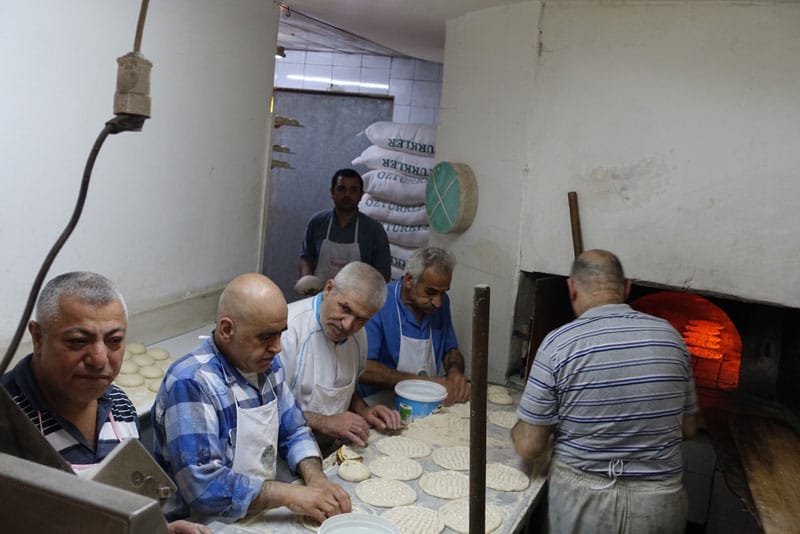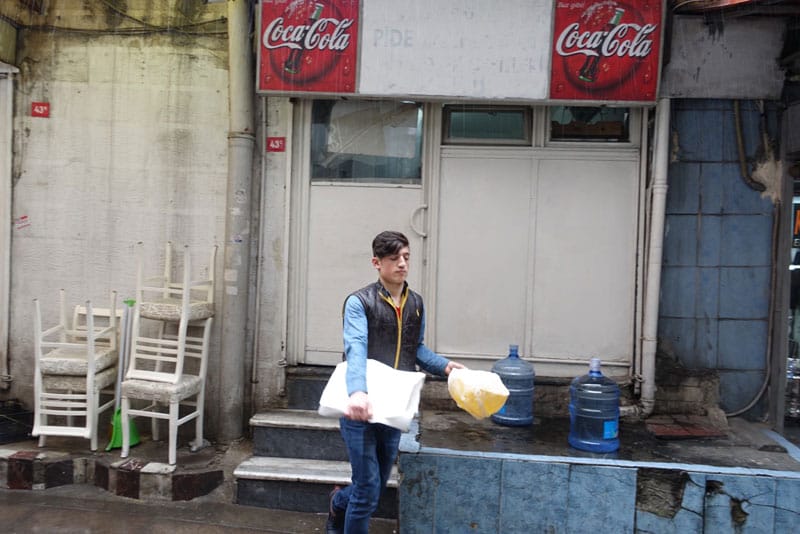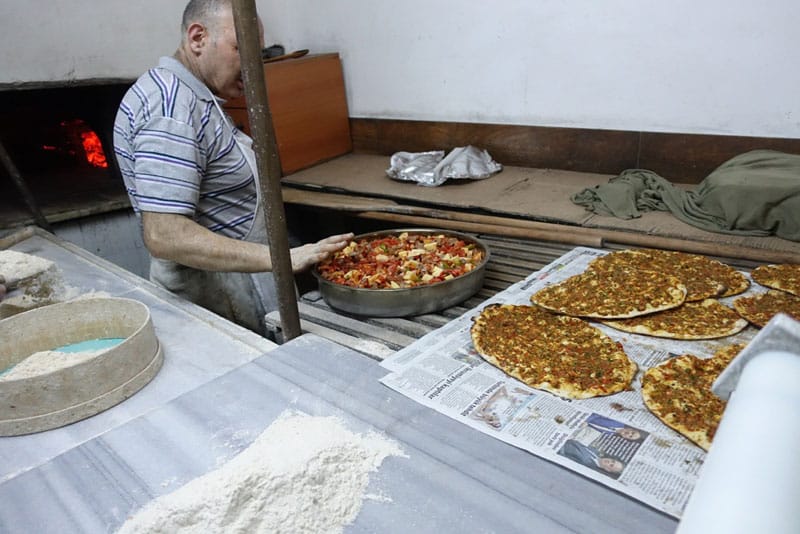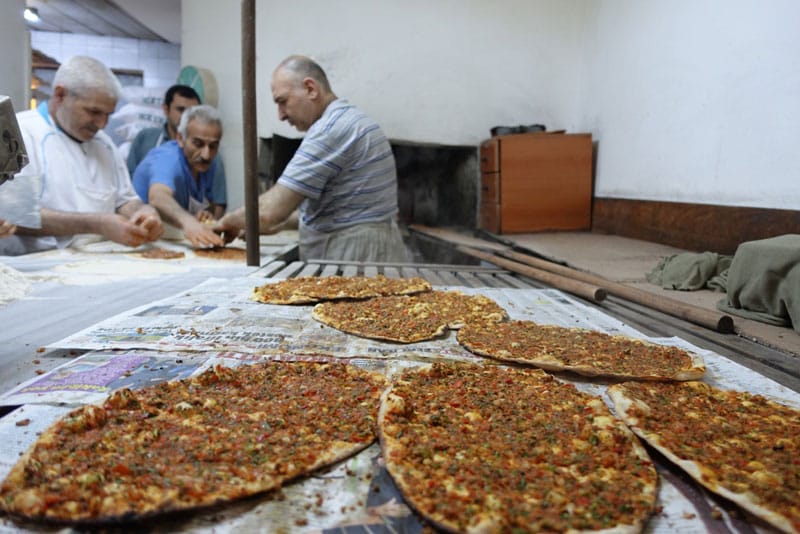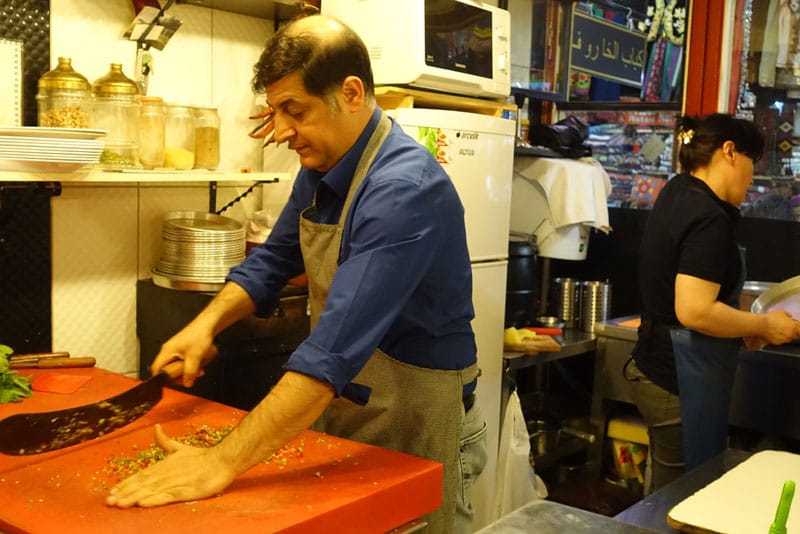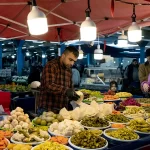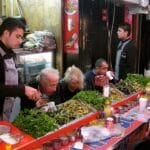We are sure that many parallel universes exist within the labyrinthine Grand Bazaar of Istanbul, one of the world’s biggest and oldest covered markets.
The easiest one to access is a world of Prada knock-offs, Minion keychains and leather-bound menus presented with “Please, monsieur, fresh fish, Turkish kebab, hola!” This is the world constructed for foreign tourists, but step off the main streets and into the bazaar’s tiny arteries, and, as if stepping through a magic wardrobe, you’ll be transported into the local life of the bazaar.
Here, currency is traded in a scrum that resembles the pit of the Chicago Board of Trade, gold coins are purchased from miniscule jewelry shops for an upcoming circumcision fête, and lunch is prepared according to the Anatolian convention that calls for a wood-burning oven and a squadron of traditional bakers.
This is the pact of a meal at Rejon, a small kebab shop in an alley within the bazaar known for a cluster of shops run by Turkmen from Afghanistan selling Uzbek tapestries, Dagestani daggers and afro wig-like wool hats from Georgia. The occasional tourist may wander in and order a tavuk şiş, but the pride and joy of Rejon is the Kilis tava, a thin, spiced meat patty that is fired in an oven and eaten with a heap of flatbread, as it is done in Kilis, a town located near Turkey’s southern border with Syria.
On a recent visit, Durmuş Yedikaya, the owner of the shop, patiently waited beside a thick slab of a cutting board, his scimitar-like zihr knife waiting for the lunch rush. He was called up from Kilis to work this shop by his cousin in 1986. Six days a week for almost 30 years he has been working this small restaurant, making Kilis tava.
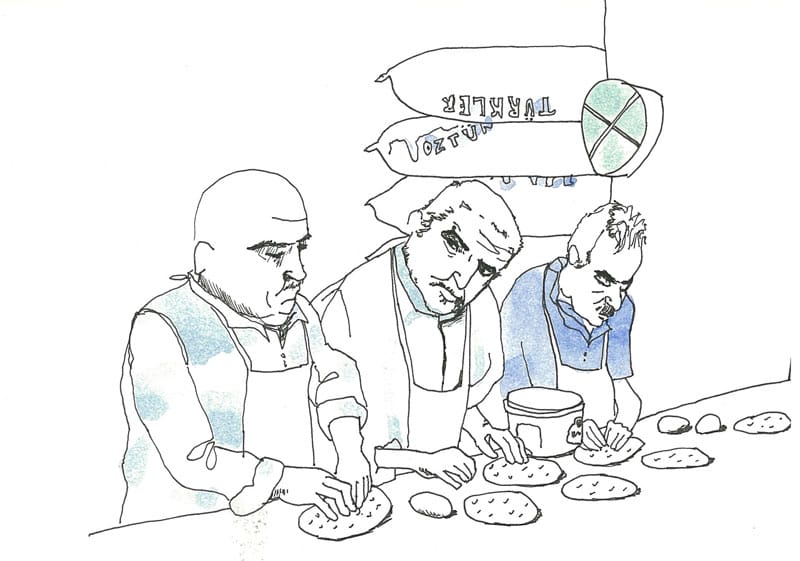
Kebab is in the blood. Back in Kilis he was an apprentice, working in his father’s butcher shop. And in Kilis a butcher not only cuts meat, but is often also charged with the preparation of Kilis kebab, made by taking a thin patty of minced meat mixed with peppers, onions and spices and laying it over thinly sliced potatoes or eggplant on a wide, round dish. The concoction is then walked over to cook in the wood-burning fırın over at the local bakery, usually within whiffing distance of a butcher shop and probably very close to the greengrocer where the produce used in the kebab had been sourced.
It’s a symbiotic relationship between the customer and the ancient local guilds that employ several different tradesmen, all masters of their individual, narrow craft. It may seem burdensome to deal with every stage of production of your lunch, but as a system, it indulges the finicky eating ways that run deep in this land, allowing the diner to control a myriad of variables (“A little less fat in the meat,” you may tell the butcher; “not those peppers but those peppers,” you may specify to the greengrocer; you may needle the baker for the exact time that the bread came out of the oven, and while you are waiting for a fresh batch you might chat with the owner and decide whether you still really like his attitude). At the same time, it preserves the singular integrity of the guilds while engendering an esprit de corps in the market.
It takes a village to cook a Kilis tava.
Around lunchtime across Anatolia, behold the sight: bakeries are clogged with customers bringing in their own bulky pans to be cooked in the oven. In a town called Iskilip, at the mouth of a wide stone oven, we saw what must have been a dozen clay güveç pots with women’s names crudely chalked on the side, so Ayşe doesn’t mix up her beans with the lamb stew waiting for Fatma. In the bazaar of landlocked Elazig, a city far from the Turkish shorelands, we saw a pan of hamsi, Black Sea anchovies, emerge from the oven. In Gaziantep, near the castle, the bakery ovens are so crowded with pans of eggplant kebab, it’s hard to imagine they actually turn out bread.
So when Durmuş bey arrived in Istanbul for the purpose of making Kilis tava in the Grand Bazaar, he assumed there would be a bakery on the same street, and he was correct, almost.
“You cannot have a real fırın in the Grand Bazaar,” he explained. “The chimneys, wood, it’s not possible.”
In Istanbul, long besmirched by cynical Anatolians as the place where culinary tradition goes to die, you might expect the clever marketeers of the Grand Bazaar to employ a microwave or a blowtorch in the absence of an oven, but what’s special about the world of Rejon is that they’ve adapted a system that is more or less that of Kilis.
 Here’s how it goes: Durmuş bey heaps the ingredients of the Kilis tava onto the cutting board and goes to work with his great knife, chopping and mixing them to the desired consistency. He then spreads it evenly into a half-inch thick disc of meat over a layer of paper-thin potatoes. He scatters onions and peppers over the top and passes it to a young waiter, who covers it with newspaper and sets off at a good clip through the bazaar. On our visit, we followed our kebab to see where it would be cooked. A trail of breadcrumbs couldn’t have led us back to Rejon. We twisted and turned through alleys and tight blind passes (one marked “magic passage” in Turkish) and out a door into the rain. Finally, we arrived at a nameless storefront just outside of the bazaar and entered into a hive of activity, a real Anatolian fırın.
Here’s how it goes: Durmuş bey heaps the ingredients of the Kilis tava onto the cutting board and goes to work with his great knife, chopping and mixing them to the desired consistency. He then spreads it evenly into a half-inch thick disc of meat over a layer of paper-thin potatoes. He scatters onions and peppers over the top and passes it to a young waiter, who covers it with newspaper and sets off at a good clip through the bazaar. On our visit, we followed our kebab to see where it would be cooked. A trail of breadcrumbs couldn’t have led us back to Rejon. We twisted and turned through alleys and tight blind passes (one marked “magic passage” in Turkish) and out a door into the rain. Finally, we arrived at a nameless storefront just outside of the bazaar and entered into a hive of activity, a real Anatolian fırın.
Inside, a radio played folk tunes and everyone seemed to be talking at once; other waiters were placing orders, bakers mumbling to each other. Two bakers snacked on raw peppers as they worked, shaping loaves of flatbread, spreading out a brilliant, crimson smear to top matzo-thin lahmacun that was also being baked here. Sacks of flour lined the wall leaving a narrow aisle for the assistant bakers working at the long marble counter that ringed the hulking oven at the center of the room. The man working the oven slid a long paddle lined with rounds of pale dough to deposit, removing trays of glistening kebab.
“You must go to Kilis for this!” shouted Ahmet, the head baker. He proudly proclaimed Kilis as his hometown and that of the rest of his staff. “Kilis!” he repeated several times as our kebab sat in the oven as if cheering on a soccer team.
In theory, you can wander into this bakery and buy lahmacun or some fresh bread from Ahmet, but he might not know what to do with you. Almost all of his transactions come in the form of waiters sourcing oven-baked essentials for restaurants all over the bazaar. Payments aren’t made on the spot but tallied up and settled on a weekly basis. Then, of course, there’s the issue of simply finding the place.
If you’ve had a kebab lunch within the confines of the Grand Bazaar, chances are that the bread you munched came from Ahmet’s oven. Finding this bakery just outside one of the city’s most touristy sites and witnessing in Istanbul the rhythm of places we have visited far east of it was the most pleasant of revelations for us. We’d located the secret pulse of the Grand Bazaar.
When our kebab emerged from the oven, it was covered once again in newspaper. Our waiter fashioned little potholders from two wads of newspaper so he didn’t burn his hands on the way back to Rejon. We followed him back through the bazaar to our table, which was set with cups of frothy ayran in metal cups. This kebab “for two” could have fed us and all of the shopkeepers sitting out front, but we sliced, munched and spun the round dish on our table like a lazy Susan until all that was left was a slick of oil and some potatoes that wouldn’t relent to our fork. Luckily we had a heap of Ahmet’s bread to finish that up.
Sure, Kilis tava could be easily described as a flattened meatloaf cooked in a primitive oven, but we think the efforts displayed at Rejon deserve more careful consideration. There’s the knife work that allows the right consistency and balance between the ingredients that go into the mince. The thickness – or rather, thinness – of the kebab, meanwhile, is a perfect match for the intense enveloping heat of a wood-fired brick oven. There’s a light char on the surface of the minced meat and vegetables and a smoky aroma hovering above them, but below the textured surface everything is cooked just the way you want it – potatoes as if they’ve been slow roasted in oil for a long while, peppers and tomatoes like they are fresh off of the grill, onions almost sautéed and meat pleasantly charred. That is the magic of a traditional fırın worked by an experienced baker.
But what we like best about Kilis tava is the collaboration. It takes a village to cook a Kilis tava, and the one at Rejon is evidence that that village is alive and well, even in the Grand Bazaar.
This article was originally published on August 8, 2016.
AnselOlga Alexopoulou
Published on August 31, 2019
Related stories
March 30, 2022
IstanbulQuick bite: Far from the tourist trail, get a taste of one of the last bastions of classic Istanbul flavors, including bread fresh from the tandir oven, a mind-boggling assortment of meze, sizzling kebab, old school ice cream and much more. On this full-day food tour, we will dig deep into the culinary traditions of…
February 18, 2016
IstanbulQuick bite: Istanbul’s Bazaar Quarter is one of the world’s biggest open-air commercial centers and a historic hub of small craftsmen who still carry on their tradition in the atmospheric caravanserais. On this 6-hour Grand Bazaar food tour, we will meet and eat with these craftsmen. Istanbul’s Bazaar Quarter is one of the world’s biggest open-air…
May 5, 2015
IstanbulAs we’ve written here before, if you do a little rooting around, the Grand Bazaar can be as much about the food as it is about the shopping. Case in point: Aynen Dürüm, a microscopic kebab shack at the edge of the sprawling bazaar that serves exceptionally good wraps (or, as they’re called in Turkish,…







































